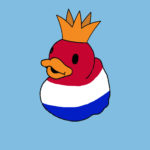What is a gyre?
The term Plastic soep refers to all of the plastic polluting the ocean: from plastic bags floating near the surface, to the plastic resting on the sea floor. Scientists have found more plastic floating in some areas of the ocean than in others. That’s because the plastic is collected in five ‘gyres’..
What is a gyre?
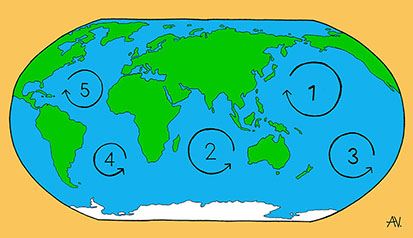
There are five ocean gyres: 1) North Pacific gyre; 2) Indian Ocean gyre; 3) South Pacific gyre; 4) South Atlantic gyre, and; 5) North Atlantic gyre. All of these gyres are located in the sub-tropical zones, just above and below the equator.
People sometimes talk about islands of plastic floating in the ocean. That’s not the case, but there are some parts of the ocean where we can find more plastic than in other areas. That is because the plastic is collected in five gyres. A gyre is a circular current at the ocean’s surface. The current around these gyres is the main transport mechanism for the spread of floating plastic 2 .
How is a gyre created?
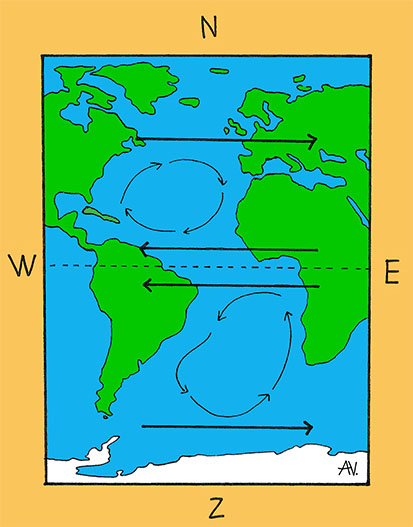
In the Northern Hemisphere, the gyres flow towards the west, and in the Southern Hemisphere they flow towards the east.
Gyres are created when the wind blows over the surface of the ocean. The wind pushes the water along with it. As you can see in this illustration, in the Northern Hemisphere the wind blows along the top of the gyre towards the east, pushing the water in an easterly direction. At the bottom of the gyre, the wind blows towards the west, pushing the water in a westerly direction. When the current reaches a continent, it is forced to bend along the coast, giving the gyre its characteristic ring-like shape.
Why don’t all gyres flow in the same direction?
The gyre currents flow in different directions due to the Coriolis effect. Due to this Coriolis effect, the currents in the Northern Hemisphere turn in a clockwise direction, and in the Southern Hemisphere they turn counter-clockwise.
Plastic collects in the gyres
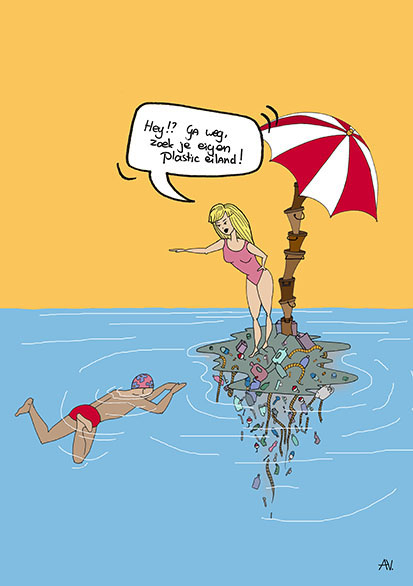
Did you know… that there are no ‘plastic islands’? The plastic soup is more like a watery bouillon.
The water in the gyre flows towards the middle of the gyre, where it sinks to the ocean floor. This circular motion gradually carries plastic to the centre of the gyre. Since some of the plastic floats, it isn’t carried down by the current, but remains in the middle of the gyre 3. There are five places in the ocean where the plastic collects, and all of them are in the centre of gyres 4,5,6,7,3. There, the concentration of plastic is 10 kg per square kilometre 6,3. That is nowhere near a ‘plastic island’, but it is a higher density of plastic than in other areas of the ocean.
Dutch plastic harms the North Pole
The gyres are not the only place where plastic collects in the ocean. As this article in this article in Trouw explains, one of these places is the North Pole. Surface currents carry plastic from the Netherlands to the Arctic Ocean, where the water sinks to the ocean floor. The floating plastic, however, stays at the surface, where it causes major damage to the Arctic region and everything that lives there.
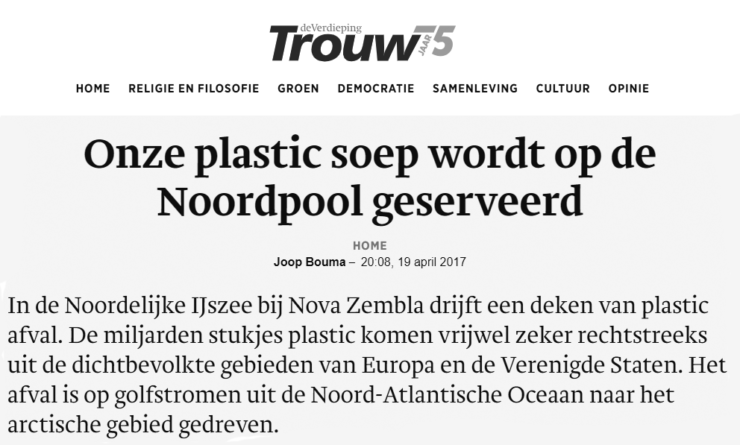
Read in Trouw about the effects that our plastic from the Netherlands has on the polar region.
2 Barnes, D. K., Galgani, F., Thompson, R. C., & Barlaz, M. (2009). Accumulation and fragmentation of plastic debris in global environments. Philosophical Transactions of the Royal Society of London B: Biological Sciences, 364(1526), 1985-1998.
3 van Sebille, E. (2015) The oceas’ accumulating plastic garbage. Physics Today, 68, 60-61. – Website
4 Law, K. L., Morét-Ferguson, S., Maximenko, N. A., Proskurowski, G., Peacock, E. E., Hafner, J., & Reddy, C. M. (2010). Plastic accumulation in the North Atlantic subtropical gyre. Science, 329(5996), 1185-1188.
5 Law, K. L., Morét-Ferguson, S. E., Goodwin, D. S., Zettler, E. R., DeForce, E., Kukulka, T., & Proskurowski, G. (2014). Distribution of surface plastic debris in the eastern Pacific Ocean from an 11-year data set. Environmental science & technology, 48(9), 4732-4738.
6 Cózar, A., Echevarría, F., González-Gordillo, J. I., Irigoien, X., Úbeda, B., Hernández-León, S., … & Fernández-de-Puelles, M. L. (2014). Plastic debris in the open ocean. Proceedings of the National Academy of Sciences, 111(28), 10239-10244.
7 Eriksen, M., Lebreton, L. C., Carson, H. S., Thiel, M., Moore, C. J., Borerro, J. C., … & Reisser, J. (2014). Plastic pollution in the world’s oceans: more than 5 trillion plastic pieces weighing over 250,000 tons afloat at sea. PloS one, 9(12), e111913.
8
More interesting info…
